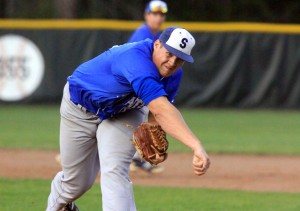What’s The Ideal Body Type For A High School Righthander Anyway?


When 6-foot-5, 250-pound Tyler Kolek goes off the board near the top of the 2014 draft, he will become the heaviest high school righthander ever selected in the first round.
In fact, we can find just five first-round righties in the first 49 years of draft history who were listed at 230 pounds or heavier at the time they were selected.* In order of appearance:
| Year | No. | Team | HS Righthander | HT | WT | Peak Level |
| 1989 | 12 | Astros | Jeff Juden | 6-7 | 240 | Majors (533 IP for 8 teams) |
| 1993 | 23 | Brewers | Jeff D’Amico | 6-6 | 235 | Majors (784 IP for 4 teams) |
| 1995 | 26 | Braves | Chad Hutchinson^ | 6-6 | 230 | Majors (4 IP in 2001) |
| 1996 | 7 | Giants | Matt White^ | 6-5 | 230 | Starter at Double-A |
| 2009 | 5 | Orioles | Matt Hobgood | 6-4 | 245 | Reliever at High-A (active) |
| ^ Did not sign with drafting team | ||||||
Even in such a small sample, the track record for the heaviest first-round prep righthanders is spotty. Hobgood and White have failed to reach the majors despite being the highest overall picks, while Hutchinson made just three mop-up relief appearances for the 2001 Cardinals, who signed him as a second-round pick out of Stanford in 1998 after he spurned the Braves out of high school.** D’Amico (4.61 ERA) and Juden (4.81 ERA) had windows of effectiveness in the majors, but despite large, supposedly durable frames, neither had more than two seasons in which they topped 160 innings.

Tyler Kolek (Photo by Mark Anderson)
This got us wondering about the ideal frame for an high school righthander, keeping in mind that as an 18-year-old, he probably will add weight as he matures. Just like we all do.
An athletic trainer asked about the ideal frame for a draft-eligible, teenage pitcher estimated that the following characteristics would be most desirable: 6-foot-3, about 180 pounds and with long legs, long arms and a short torso.
A regional crosschecker for a National League team that will have no shot at Kolek said, “If you look at the Hall of Fame, it is full of 6-feet to 6-foot-3, athletic pitchers.”
Said a farm director for an American League club that also won’t have access to Kolek: “My guess is most teams would prefer the more ‘normal’ body type, assuming the pitcher is between 6-foot-2 and 6-foot-4, because I think those guys would be considered more projectable and generally looser.”
Not surprisingly, both veteran baseball men are correct in their assertions. Of all the righthanders to gain entry to the Hall of Fame during the past 50 years–with select recently-retired HOF worthies strewn in***–the median height for the group is 6-foot-2, and the median weight is 190 pounds. Heights range from the 5-foot-11 Pedro Martinez to the 6-foot Catfish Hunter, Greg Maddux, Juan Marichal and Robin Roberts to the 6-foot-5 Don Drysdale, Fergie Jenkins and Curt Schilling.
Meanwhile, a majority of the 209 high school righthanders ever taken in the first round (56 percent) stand between 6-foot-2 and 6-foot-4. Another 27 percent of the sample is listed at either 6-foot-1 or 6-foot-5, clustered one tick outside the estimated sweet spot. That means that the height for roughly four out of five first-round prep righties will fall within a narrow range of five inches.
A Tale Of Two Body Types
Given just two inputs–height and weight–we can take the examination of prep righty body types in another direction through use of the body mass index (BMI) measurement, which yields a relative weight that can be used to classify members of the general population as underweight, normal or overweight.
The World Health Organization deems a BMI between 18.5 and 25 to be in the “normal” range, and those exceeding 25 to be “overweight.” Dividing all the high school righties ever taken in the first round into those two groups based on this BMI cutoff yields interesting results–results that may or may not be instructive.
Before presenting the results, though, consider these three caveats: (1) professional athletes really can’t be considered part of the general population, given their much-more-rigorous training habits, (2) body types have changed in the five decades since the draft began, so making direct comparisons between a pitcher in 1965 and today carries obvious risks, and (3) forcing all pitchers into rigidly-defined groups does not account for subtle differences in height, weight or body type. However, the BMI results are interesting, and our sample of 209 prep righties spread over 49 drafts is fairly robust.

Roy Halladay (Photo by Diamond Images).
Not surprisingly, teams prefer to spend first-round picks on “normal” high school righties, taking those with a BMI of 25 or lower three times as often (157) as those with a BMI greater than 25 (52). Teams view these pitchers as looser, more athletic, more projectable and more deserving of selection in the first round–but are they better bets?
In a word: Yes.
While roughly 60 percent of each prep righty group has reached the majors, those in the “normal” BMI bin have produced an average of 7.9 Wins Above Replacement, according to Baseball-Reference.com’s estimates, with a median return of 2.1 WAR. Those with a BMI in excess of 25, meanwhile, have yielded 4.0 WAR on average, with a median return of just 0.2 WAR.
Let’s put names to the results, first drawing up a top 10 list based on career WAR totals for first-round prep righties with a BMI of 25 or lower at the time they were drafted. These are the “normal” body types. Keep in mind that teams selected righthanders with this body type three times as often, meaning the candidate pool is three times as large.
| Year | No. | Team | HS Righthander | HT | WT | BMI | WAR |
| 1995 | 17 | Blue Jays | Roy Halladay | 6-5 | 200 | 23.7 | 64.7 |
| 1982 | 5 | Mets | Dwight Gooden | 6-3 | 183 | 22.9 | 53.2 |
| 2002 | 6 | Royals | Zack Greinke | 6-2 | 185 | 23.8 | 38.6 |
| 1971 | 20 | Dodgers | Rick Rhoden | 6-3 | 195 | 24.4 | 35.9 |
| 1999 | 2 | Marlins | Josh Beckett | 6-4 | 200 | 24.3 | 34.4 |
| 1974 | 21 | Dodgers | Rick Sutcliffe | 6-5 | 205 | 24.3 | 34.3 |
| 2002 | 25 | Giants | Matt Cain | 6-3 | 185 | 23.1 | 32.6 |
| 2000 | 29 | Braves | Adam Wainwright | 6-7 | 195 | 22.0 | 31.8 |
| 1995 | 4 | Cubs | Kerry Wood | 6-3 | 185 | 23.1 | 27.7 |
| 1978 | 4 | Athletics | Mike Morgan | 6-3 | 195 | 24.4 | 26.6 |
The average height/weight for this group is 6-foot-4, 193 pounds and includes two of the highest-paid righthanders on the planet (Cain, Greinke), a staff ace for last year’s NL pennant winner (Wainwright) and five Cy Young Awards.
Now for the top 10 WAR earners for those high school righties with a BMI greater than 25 at the time they were drafted.
| Year | No. | Team | HS Righthander | HT | WT | BMI | WAR |
| 1993 | 15 | Blue Jays | Chris Carpenter | 6-5 | 220 | 26.1 | 34.5 |
| 1988 | 24 | Brewers | Alex Fernandez | 6-1 | 205 | 27.0 | 28.9 |
| 1999 | 12 | Phillies | Brett Myers | 6-4 | 210 | 25.6 | 14.4 |
| 1972 | 3 | Phillies | Larry Christenson | 6-4 | 215 | 26.2 | 10.6 |
| 2011 | 14 | Marlins | Jose Fernandez | 6-3 | 215 | 26.9 | 7.7 |
| 2004 | 23 | Yankees | Phil Hughes | 6-5 | 220 | 26.1 | 7.2 |
| 1985 | 14 | Braves | Tommy Greene | 6-5 | 225 | 26.7 | 7.1 |
| 1993 | 23 | Brewers | Jeff D’Amico | 6-6 | 235 | 27.2 | 5.6 |
| 2001 | 26 | Athletics | Jeremy Bonderman | 6-1 | 210 | 27.7 | 5.2 |
| 1994 | 10 | Indians | Jaret Wright | 6-2 | 218 | 28.0 | 4.7 |
The average height for this group also is 6-foot-4, but the average weight is nearly 25 pounds heavier at 217.
Carpenter served as an unquestioned ace for the Cardinals beginning in 2004, but it took him a decade (and several injuries from which to recover) to get to that point. Jose Fernandez could resume his ace trajectory when he returns from Tommy John surgery in 2016, but no one in this group, outside of Carpenter, had an extended run of dominance, and the high ranking by Fernandez after just seven-plus months in the big leagues speaks to an overall lack of success.
The results reinforce teams’ preference for athletic prep righthanders who check in at about 6-foot-3 or 6-foot-4 and 190 pounds. As with everything, exceptions to the rule exist, which will make monitoring Kolek and other big-bodied prep righties from the 2014 draft class in pro ball a fascinating endeavor.
“If there is any frame that could take 200 innings, it’s (Kolek’s),” the crosschecker said. “In the draft, you look for special players. Well, he has all of the tools. (Taking him in the first round) wouldn’t bother me a bit.”
Footnotes
* Of course C.C. Sabathia, at a listed weight of 240 pounds, is the heaviest high school lefthander drafted in the first round. He went 20th overall to the Indians in 1998. Though at 220 pounds, Madison Bumgarner (2007) and Clayton Kershaw (2006) weren’t too far behind Sabathia on the list.
** Fittingly, Hutchinson spurned the Cardinals in 2002 to play quarterback for the NFL’s Dallas Cowboys.
*** The complete sample of Hall of Fame (and HOF worthy) righthanders: Bert Blyleven, Kevin Brown, Jim Bunning, Roger Clemens, Don Drysdale, Dennis Eckersley, Rollie Fingers, Bob Gibson, Goose Gossage, Catfish Hunter, Fergie Jenkins, Greg Maddux, Juan Marichal, Pedro Martinez, Jack Morris, Mike Mussina, Phil Niekro, Jim Palmer, Gaylord Perry, Robin Roberts, Nolan Ryan, Curt Schilling, Tom Seaver, John Smoltz, Bruce Sutter, Don Sutton and Hoyt Wilhelm.

Comments are closed.